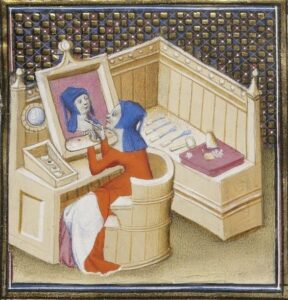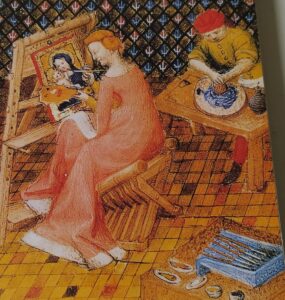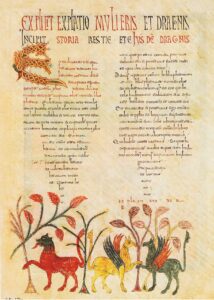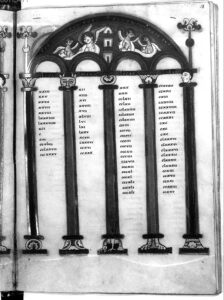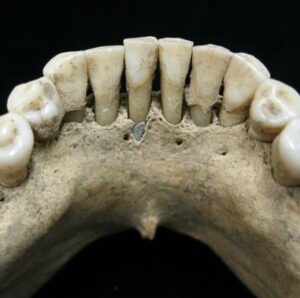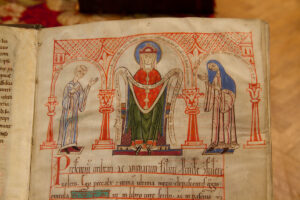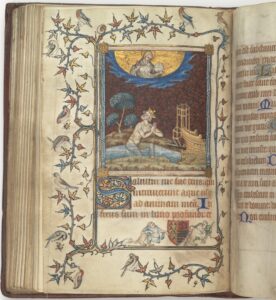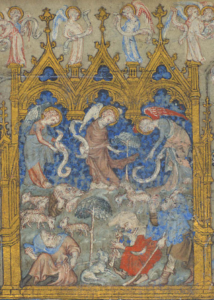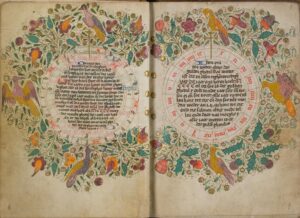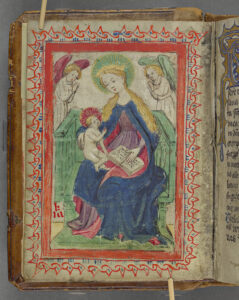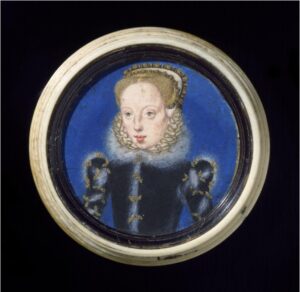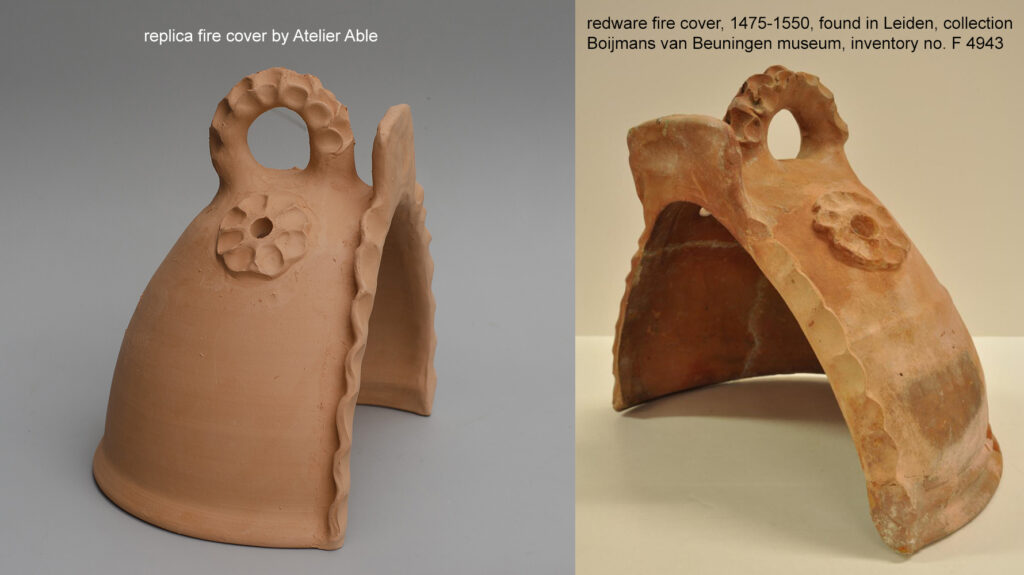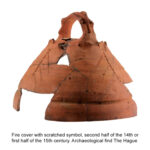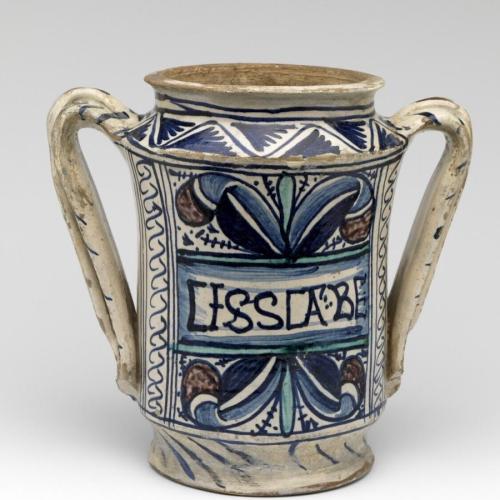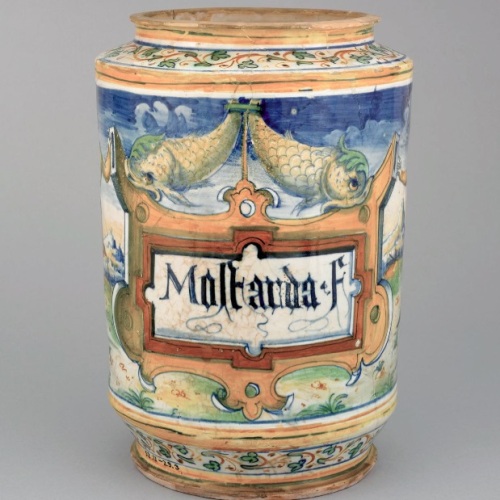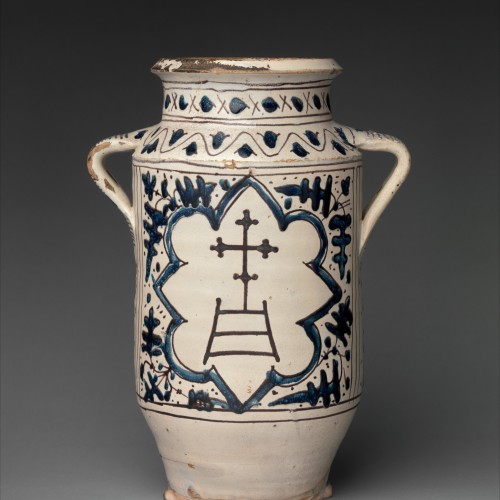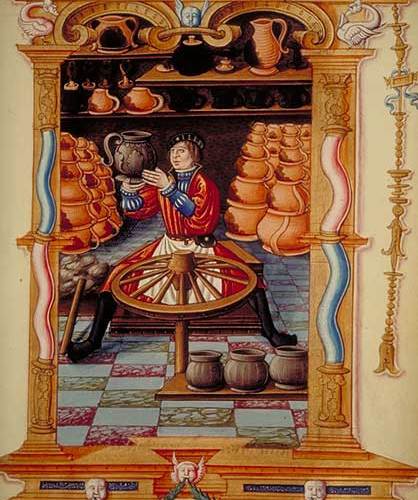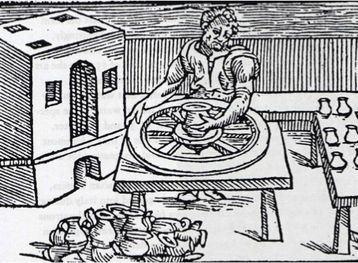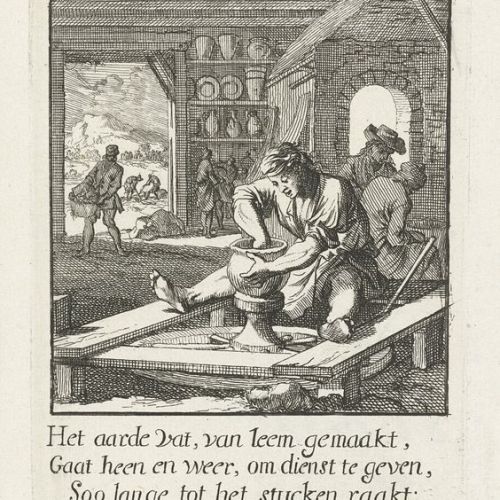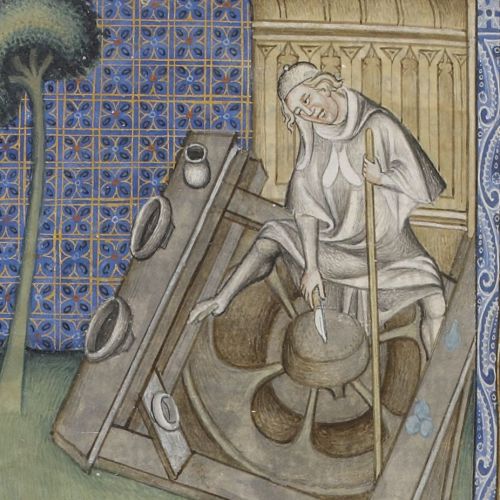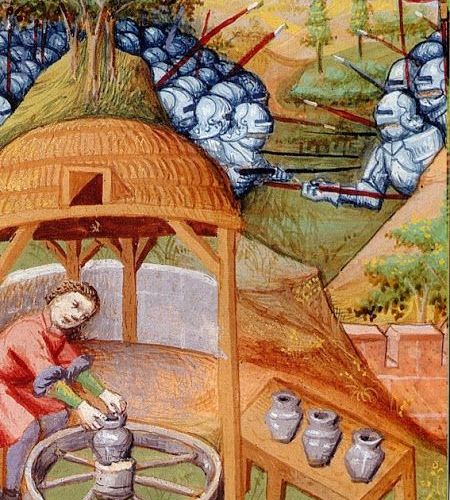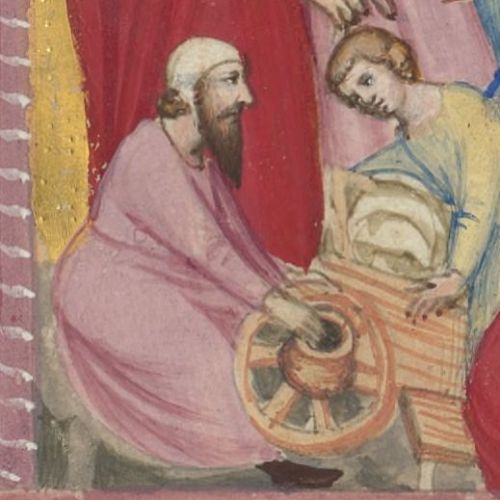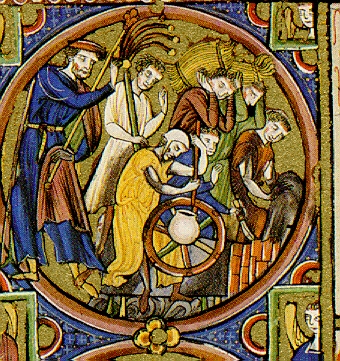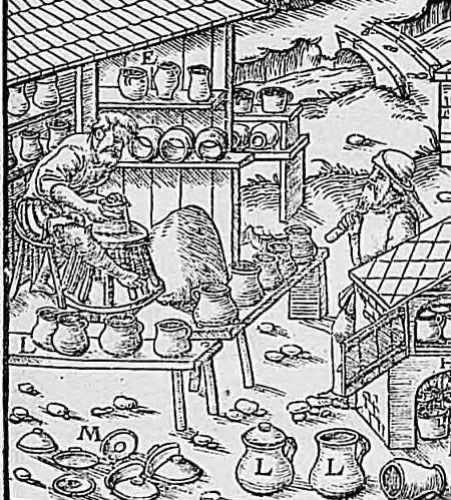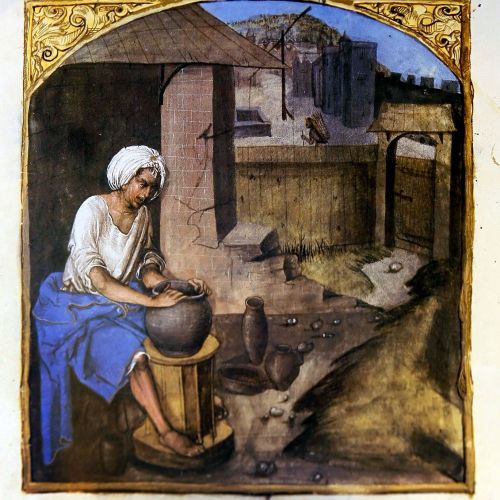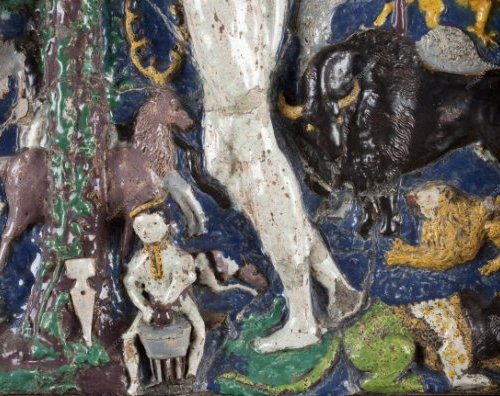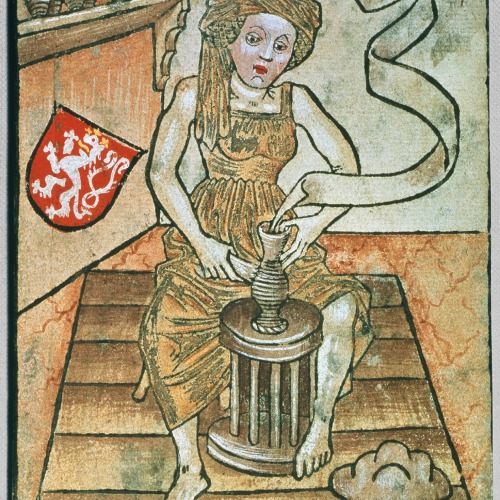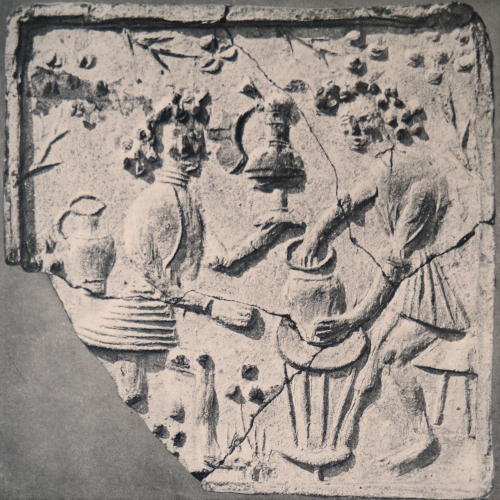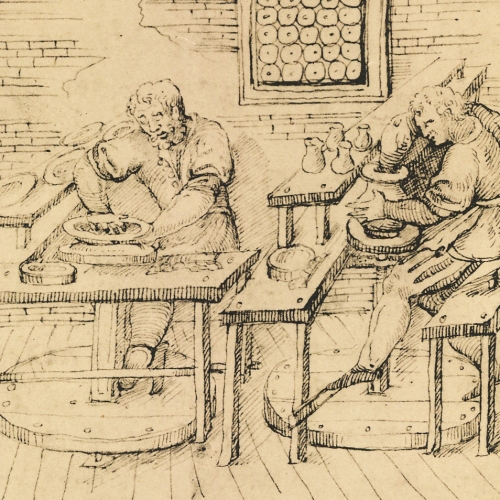Fresh pottery from the kiln. Replica’s of mostly medieval and early modern ceramics. An owl beaker, Italian majolica, Delftware, Spanish lusterware, a puzzle jug and more!
Decorating an owl beaker
Some time ago, I had the opportunity to see a 400 year old owl beaker in the Boijmans van Beuningen depot. Here I’m working on a replica. The technique used for decorating this kind of luxury pottery was oxide pigments on top of a white tin glaze. In this video I’m working with cobalt, which will turn blue when fired.
Firing session coming up
One day before firing. Tomorrow is a hot day for these cups, jugs, bowls, whorls and dishes.
Wig stand or…
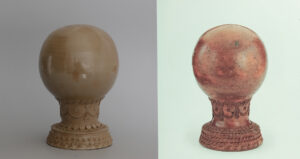
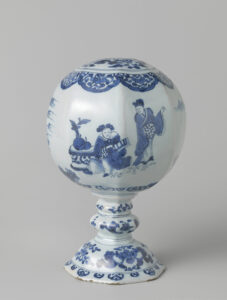

about the peasant dance jug – over de boerendanskruik
Peasant dance jug
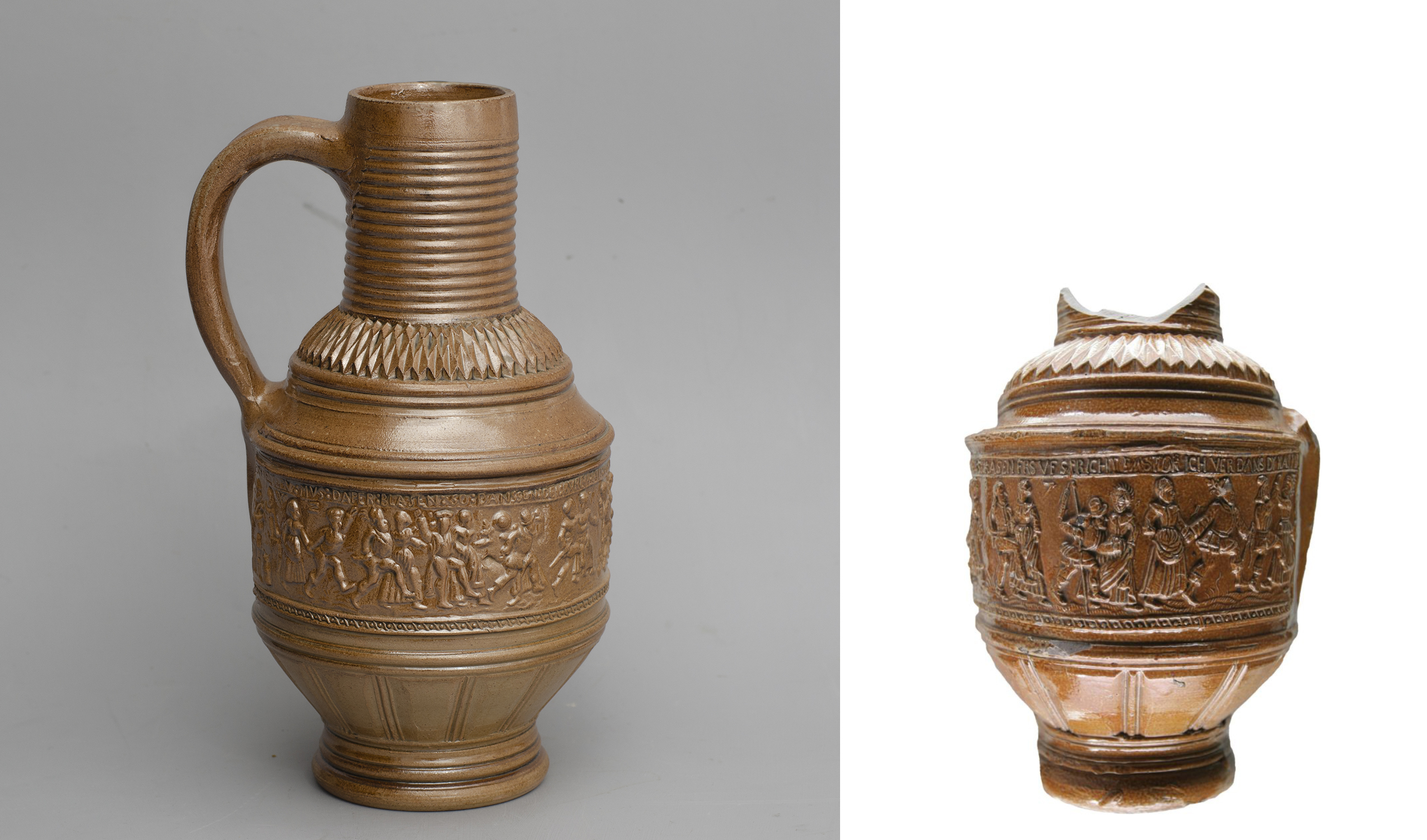
Female miniature painters
lees dit artikel in het Nederlands

- 1 Jeanne de Montbaston at work, detail from a copy of the Roman de la Rose made by her and Richard, 14th century, BnF. MR. fr. 25526, fol. 77v
While writing an article about medieval painting materials, I noticed that some of the most famous miniatures of artists’ studios show women as painters. Since medieval Europe has a rather misogynistic reputation, I saw these images as a refreshing source for a different perspective. Could they shed a different light on the androcentric image we have of the Middle Ages? The miniatures in question represent classical artists, already mentioned by Pliny the Elder: Irene (3rd century BC), Timarete (5th century BC) and Marcia (originally Iaia 116–27 BC). Giovanni Boccaccio mentioned these women in 1362 in De mulieribus claris (On Famous Women), a collection of 106 biographies of historical, biblical and mythical women. We can’t grasp the daily reality of medieval craftswomen on the basis of these miniatures. But the images did arouse my curiosity. I soon discovered that women were particularly well represented as miniature painters. Who were these women? What was their social position? Do we know their names? Have their works of art been preserved? And what can we learn from them? I will try to answer these questions in this article.
- 2 Irene in De mulieribus claris, 1403, Bibliothèque nationale, Paris. MS Français 598, f. 92r.
- 3 Marcia making a self-portrait, De mulieribus claris, 1403, Bibliothèque nationale, Paris. MS Français 598, f. 100v.
- 4 Timarete in front of her easel in a French translation of De mulieribus claris Bibl. nat. de France Ms. fr. 12420 f. 86r.
Early Middle Ages
Frankish miniature painters
In the Middle Ages it was customary not to sign miniatures, which is why many makers have remained anonymous. Sometimes names can emerge from other source material, such as preserved accounts and book lists. The further you go back in time, the fewer sources there are. Artists from the early Middle Ages are therefore very difficult to trace. Nevertheless, Felice Lifeshitz attempts to demonstrate that women played an important role in book production in the Frankish Empire. She conducted a study on ‘women’s books’ in the Main valley in the 8th century. To begin with, the first demonstrable book collectors from this region were women.[1] In addition, the scriptoria (writing rooms) in the nunneries of Karlsburg and Kitzingen count among the oldest in the area. Lifeshitz identifies two groups of manuscripts that were probably made in these monasteries. The oldest group is associated with the name Gun(t)za: she wrote her name twice in a florilegium (plant book) among this collection.[2] The younger group contains a manuscript with homilies (sermons) of Gregory the Great in which Abirhilt has written her name.[3] Lifeshitz believes she played a leading role in the scriptorium.
In one of the Abirhilt manuscripts there is an exceptional and among experts praised crucifixion. For as far as we know, the condemned thieves on either side of Jesus in this version of the crucifixion are the first to be picked up by (left) angels and (right) messengers from hell.[4] Because the page is unsigned, it has not previously been treated as a woman’s artwork. Lifeshitz’ intensive research shows that an analysis of the work yields new insights if we assume that it has been made by woman. She places the manuscripts and the miniature for the first time within the context of an intellectual feminist community avant la lettre, with the nunneries of Karlsburg and Kitzingen as important hubs. The nuns appear to have handed down a theology in which the misogynistic image with the emphasis on virginity and victimhood fades into the background and female strength and autonomy come to the foreground through a careful choice of religious texts.[5] For example, in the expositions of the psalms by Augustine (from the Gun(t)za group: Wurzburg, UB Mpth.f. 17, the Karlburg Augustine) large parts of his commentary on psalms 131-133 are omitted. These are precisely the passages in which women are portrayed as weak and inferior people. His exposition of psalm 133 treats Eve as the dangerous temptress of Adam and all men after him and he accuses Job’s wife of leading her husband astray.[6] Lifeshitz sees the omission of these passages as a deliberate choice by the female copyist. She points to the existence of manuscripts from the famous scriptorium of Chelles, where the nuns surgically removed misogynistic passages from texts by Augustine.[7] Apparently, this critical approach towards religious texts is demonstrable outside the scriptoria of Karlsburg and Kitzingen as well: a hallmark of self-confident women who did not blindly copy what was presented to them by the Church Fathers.
- 5 Beatus of Girona completed 975 illuminated by En and Emeterius f. 176v
- 6 Letters of Paulus, Kitzingen, 8th century, Würzburg, UB Cod. M.p.th.f. 69, fol. 7r
- 7 Beatus of Girona f. 176r completed 975 illuminated by En and Emeterius
En: a signed manuscript
For a beautiful example of a miniaturist known by name, we turn our attention to a 10th-century manuscript from Spain. In the colophon of this “Beatus of Girona”, which is kept in the Cathedral of Girona, we find the first known female miniature painter of Spain. The literal signature reads: “En depintrix et Dei aiutrix”: “En” painter and assistant of God, also misinterpreted as Ende.[8] Not only is the fact that her name has reached us remarkable. The manuscript is also richly illustrated with its 184 preserved miniatures. The work was completed on 6 July 975, presumably in the abbey of Tábara. En worked with the monk and priest Emeterius on the illuminations, while the priest Senior functioned as scribe. It is unclear what the division of tasks was between En and Emeterius. The plates are remarkably large: most of them cover two pages and are exuberant and detailed. They are executed in the Mozarabic style: a mixture of local styles and elements from the art of the Islamic conquerors. Apart from her involvement in the creation of the Beatus of Girona, we actually know nothing about En. She may have been a nun, but if she was not, it is generally assumed that she must have been of high birth.
High Middle Ages
- 8 Illuminations in a Bible by Diemut BSB Clm 22044, p. 31, 12th century, Staatsbibliothek München
- 9 Illuminations in a Bible by Diemut BSB Clm 22044, p. 36, 12th century, Staatsbibliothek München
Diemut: copyist and illuminator?
Diemut is one of the most famous copyists of the Middle Ages. She lived from around 1060 to 1130 and probably received training at a young age, learning to write. In the Benedictine monastery of Wessobrunn she started copying religious texts, which are praised for their beautiful script. Of the 45 manuscripts that Diemut wrote, 14 were found to have been preserved in the monastery library in 1803.[9] Her authorship is evidenced by two lists of her work, one of which was written by a contemporary. By comparing her handwriting, Diemut’s style could be analyzed and distinguished from two other hands that are particularly recognizable in her later work. I have included her in this article because she probably made large initials and penwork decorations as well. The Bavarian State Library in Munich has digitized several manuscripts by Diemut, including a richly decorated Bible book with extensive illuminations. Whether these were also made by Diemut or by a colleague, I have unfortunately not been able to find out, but it is quite possible that they were made by a woman.
In the 16th century Diemut was described as an exceptionally pious person based on ancient descriptions in an attempt to provide Wessobrunn with its own saint.[10] As a result, her name has acquired a legendary tinge. It is highly questionable whether she had herself walled up in a room to dedicate her life to God as a hermit, as some sources claim.[11]
- 10 miniature with a representation of hell, modeled after the Hortus deliciarum by Herrad von Landsberg
- 11 miniature modeled after a page in the Hortus deliciarum by Herrad von Landsberg
The scriptoria of Herrad and Hildegard
The fact that so many manuscripts are unsigned does not benefit the female miniaturists. Notnames that art historians invent for the anonymous authors, usually start with “the master of …”. In this way, the impression is created in advance that the artists were men. The authors are only identified as women if the opposite can be proven, which in most cases requires a huge effort or may even be impossible. The role that women have played in the visual arts is underestimated for this reason alone. Fortunately, some anonymous manuscripts can be linked to specific scriptoria. This is the case, for example, with two world-famous books, which have become particularly well-known because of their authors. The first book, “Hortus deliciarum”, is a 12th-century encyclopedia written by Herrad von Landsberg, abbess of the Hohenberg monastery. The illuminated manuscript contained at least 684 pages and was probably produced by a workshop of women under her supervision.[12] An exceptional page in this work showed the monastic community of Hogenberg with portraits and names of 48 canonesses, 12 novices and the author-abbess Herrad herself in full length.[13] Unfortunately the original was lost during the siege of Strasbourg in 1870.[14] A few copies have survived, but they are somewhat stiff and dull. In the British Library there is a piece of parchment with scenes from the life of John the Baptist, which art historians associate with the Hohenbhttps://nl.wikipedia.org/wiki/Straatsburgerg workshop. If this work of art was indeed made there, it is the only physical work of art that remains to us from the nuns of Hohenberg. The second manuscript that I want to discuss in this context was produced under the direction of one of the most famous authors of the Middle Ages: Hildegard von Bingen. The book is called Scivias, derived from the Latin Sci vias Domini (Know the ways of the Lord). Hildegard von Bingen described her religious visions in this book and she was probably closely involved in the making of the illuminations. The painters who illuminated the Scivias codex were probably nuns from the scriptorium of the Rupertsberg monastery. This monastery was founded by Hildegard herself. Both the text and the illustrations reveal a mystical Christian worldview. The names of the miniaturists have not been handed down and the original manuscript was lost during the Second World War. Fortunately, the manuscript was copied between 1927 and 1933, so we still have a clear picture of the contents. Several preserved photographs of the original codex show that the full-page illuminations in this facsimile were also copied with the greatest possible care.
- 12 Hildegard von Bingen receives holy inspiration, image from the 20th century facsimile of the Rupertsberg Codex
- 13 Hildegard von Bingen, scivias I.6, the choirs of angels 20th century copy of the manuscript from ca. 1152
- 14 scene from the life of John the Baptist, painting attributed to the nuns of the Hohenberg monastery 1175-1200, British Library Add MS 42497
Under the microscope
Sometimes evidence of the artistic practices of medieval women turns up in unexpected places. In 2019, news channels reported that a blue artist’s pigment had been found in the teeth of a woman’s skull from Dalheim, Germany. The skull was found in a nunnery cemetery and was dated to the 11th or early 12th century.[15] Anita Radini and Christina Warinner, the researchers who found the pigment in the skull, initially had no idea what they were looking at. They had to consult with several universities before concluding that the blue substance preserved in the tartar must be very finely ground lapis lazuli, a deep blue artist’s pigment that was highly prized and expensive in medieval Europe. The pigment probably ended up in the teeth through the oral sharpening of brushes, a practice that is mentioned in later artist’s manuals.[16] The researchers also explored other possibilities. For repeated kissing of miniatures, a practice from the late Middle Ages, the skull was too old. Oral use of lapis lazuli in medicine was common in the Middle East but was highly unusual in Germany.[17] A less likely but possible explanation would be that the pigment was inhaled during the preparation of paint. But even in that case it was probably intended for her own use or that of a female colleague.
- 15 Guda in her initial, circa 1250, Guda Homiliarium, Ms. Barth. 42, f.110v
- 16 The nun’s teeth with lapis lazuli in the tartar
Portraits
In the course of the Middle Ages, self-portraits of miniaturists appear in various manuscripts. One of the first was Guda, a 12th-century nun and illuminator from Germany. She is depicted in an initial from a Homiliarium (book of sermons) of Saint Bartholomew, now known as the Guda Homiliarium. In a curled leaf motif in this letter D is written: “GUDA peccatrix mulier scripsit quae pinxit hunc librum” – “Guda, sinner, wrote and painted this book”. Based on her clothing and profession, it is assumed that Guda must have been connected to a women’s convent, perhaps in the German Rhineland. Guda should not be confused with Guta, who worked at the same time in the Schwarzenthann monastery and became famous through her portrait in the Guta-Sintram Codex. She was the copyist, while her colleague Sintram provided the illuminations. An exceptionally playful portrait can be found in the Claricia Psalter, a manuscript that originated in Augsburg around 1200. Several hands worked on the illuminations, but the attention is drawn to a woman who, swinging from her arms, represents the tail of a letter Q. Her name, Claricia, is written on either side of her head. Some consider this painting to be a self-portrait, but little can be said with certainty about her identity. Her clothing is not that of a nun, which is why some have identified her as a lay student. However, various hypotheses about her identity have never led to consensus. We do know that the psalter was intended for the Benedictine nuns of the abbey of Ulrich and Afra, and it is quite possible that the manuscript was also made there.[18]
- 17 Claricia doing gymnastics, Claricia Psalter, Walters Art Museum, c. 1200, f.64r.
- 18 Portraits of Guta and Sintram, Bibliothèque du Grand Séminaire de Strasbourg, 1154, f.4r
Late Middle Ages
Portraits
A further manuscript with a portrait of a woman is the Codex Gisle, a gradual (song book) from around 1300. This work contains several refined portraits of Gisela von Kerssenbrock as well as a record of her name in the colophon on folio 1: “This beautiful book was written, illuminated, annotated, paginated and decorated with gold letters and with beautiful images by the young lady Gisela van Kerssenbrock, in her memory in the year 1300. May her soul rest in peace. Amen”[19]. The richly decorated manuscript depicts more nuns, but only the portrait of Gisela has a name tag. We know that she was a cantrix in the Cistercian monastery Marienbrunn in Rulle. The record in the colophon seems to exclude any doubt that Gisela is the creator of the manuscript. However, her role is assessed differently by various art historians. For example, Judith H. Oliver identifies three hands in the text and concludes that Gisela rather had a leading role in the production of this manuscript and may have financed the work.[20] In her eyes, the manuscript is indeed a work of women’s hands from the Cistercian scriptorium.[21]
For another portrait we go to 15th century Italy. A richly illuminated breviary contains on the page for Advent Sunday a portrait with the caption: ANCILLA YHU CHRI MARIA ORMANI FILIA SCRIPSIT MCCCCLIII. In translation: servant of Jesus Christ, Maria, daughter of Ormanno, wrote this, 1453.[22] Maria has been identified as Maria di Ormanno degli Albizzi, an Augustinian nun from the monastery of Santa Caterina al Monte (known as San Gaggio), near Florence.[23] She came from a prominent Florentine family and became a novice on 20 November 1438. Her aunt Felice had entered earlier, Francesca di Piero degli Albizzi was the abbess and in 1447 Maria’s cousin Domitilla would join the rest.[24] It was an elite environment with women from the wealthiest patrician families such as the Medici, Orsini and Rinuccini.[25] As for the breviary, it is believed that most of it was illuminated in northern Italy. The dense and dark decorations are typical of that region and clearly differ from some of the more ornate initials elsewhere in the breviary. At the time of the manuscript’s creation, Maria was already an experienced copyist at the age of 25, and the subtle portrait may well have been made by herself, according to Kathleen G. Arthur.[26]
- 19 Gisela von Kerssenbrock in the Codex Gisle, ca. 1300, collection Diözesanarchiv Osnabrück, (f70r)
- 20 Page with text and notation in the Codex Gisle, ca. 1300, collection Diözesanarchiv Osnabrück
- 21 portrait of Maria Ormani degli Albizzi, f. 89r, Cod. 1923, Vienna, Osterreichische Nationalbibliothek
Guilds
In the late Middle Ages, more and more craftspeople and artists became active in book production outside the monasteries. The names of these makers are handed down in the books of the emerging guilds, among other sources. The secular workshops were often run by families, with men and women working side by side. In book production, however, women usually worked informally. The archives mention the male guild masters, but not their wives, daughters or other female employees. As a result, they are underrepresented in the guild books. In exceptional cases, these female colleagues can still be rescued from oblivion. Bourgot le Noir, for example, is one of the most famous miniaturists from the fourteenth century, although we know very little about her. She worked together with her father, Jean, and was probably trained by him. At some point, Jean and Bourgot moved to Paris where they could work in the vicinity of important clients. They probably produced the prayer book for Bonne de Luxembourg and the book of hours for Yolande de Flandre together. The studio later supplied employers such as the French king Charles V and Jean de Berry.
Fortunately, there were exceptions to the rule that women could not formally become miniaturists. In Bruges, a hub for the visual arts par excellence, something exceptional happened in the fifteenth century: more and more women were admitted to the St. John’s Guild of Librarians, which also included illuminators. In 1454, 12 percent of the registered members were women, and in 1480 this percentage had risen to 25.[27]
Widows had an exceptional position because they were more likely to become members of a guild. A good example is Jeanne de Montbaston, a Parisian illuminator who took her guild oath in 1353. Up until that point, she must have worked under the name of her husband Richard de Montbaston, and if he had not died so early, we might never have heard of Jeanne.[28] Their studio had a good reputation because they received commissions from the most prominent clients. For example, they were allowed to make a collection of texts about travels to the East for either King Philippe VI or Queen Jeanne de Bourgogne. According to Elena Lichmanova, this work was almost entirely provided with miniatures by Jeanne.[29] Furthermore, Jeanne immortalized herself and her husband in the margins of one of their 20 copies of the Roman de la Rose that have survived to this day. The handful of sexually suggestive marginal decorations from these works have become quite famous on the internet. The text itself is outspokenly misogynistic, so much so that Christine de Pisan attacks the authors in her collection of letters entitled “Epistres du Débat sur le Roman de la Rose.” Perhaps it is a good thing that Jeanne’s headstrong nun, who picks penises from a tree, is better known to the general public than the text above her head.
- 22 Prayer Book of Bonne de Luxembourg, 1349, probably made by Jean and Bourgot le Noir, 102v, Psalm 69 (68 Vulgate), David in the water, The Cloisters.
- 23 The shepherds in the damaged Book of Hours of Yolande de Flandres, 1353-163, Jean and Bourgot le Noir, British Library – Yates Thompson MS 27 f70v
- 24 Margin decoration from a copy of the Roman de la Rose, Jeanne de Montbaston, Paris, 14th century Bibliothèque nationale de France, Ms. fr. 25526, f. 106v.
- 25 Jeanne and Richard de Montbaston and anonymous illuminator, London, British Library, ms. Royal 19 D1 f.37v
- 26 Jeanne de Montbaston at work, detail from a copy of the Roman de la Rose made by her and Richard, 14th century, BnF. MR. fr. 25526, fol. 77v
Anastasia: a name without a picture
Via Christine de Pisan we come to the next miniaturist. In her Livre de la Cité des Dames, which appeared in 1405, Christine mentions a number of visual artists from De mulieribus claris (see introduction), but also a woman she knows herself. This is Anastasia, who is such an expert in making vines around miniatures in books and background landscapes, that in the city of Paris, where the best of the world’s craftsmen live, there is no one known who surpasses her in it, nor anyone who makes flowers and fine paintings in such a lovely way like she does, nor anyone whose work is more appreciated, so precious and valuable is the book that one receives from her, if she can finish it. And I say this from my own experience: for she has made me some things that stand out among the book decorations of other great artists.[30]
Unfortunately, we cannot form our own view on Anastasia’s achievements. Her work may well be preserved, but it has never been identified with certainty.[31]
There are many names of female illuminators whose work we do not know. They appear in the administration of monasteries, in contracts, bills, guild books, literature and so on. Although these names do not provide insight into the artistic qualities of these women, they do show that the little work that we can attribute to women is the tip of the iceberg. Many works of art have been lost and the works of art that have been preserved can rarely be linked to a person.
- 27 Book of Hours, Public Library Arnhem, OB 287 059r, signed by Sister Margariet Blocks 1469
- 28 A book of hours that can be linked to the Isendoorn convent and the convent of Saint Catherine, both in Zutphen, Royal Library in the Hague ms. 77 L 58, 1465-1485
Miniaturists from the Netherlands
What about the area we now call the Netherlands? There too, many women must have been active in miniature painting. As in the rest of Europe, book illuminations are usually unsigned. An exception is a book of hours in the public library of Arnhem (OB: ms. 287), in which folio 227r helpfully states: “Inden Jaer ons heer dusent CCCC ende LXIX is dit boec gescreven. Ende geeyndet omtrint sunte laurens mitter hant Suster Margariet blocks. Nun toe bethanien outside Arnhem.”[32] Meaning: the book was copied by Margariet Blocks, a nun in the Augustinian monastery Bathanië near Arnhem, and completed in the year 1469. The Bethanië monastery was founded around 1404 by Hendrik van Gouda from Zwolle and had its own scriptorium.[33] The book is closely linked to the region where it originated: it contains the calendar of the diocese of Utrecht and the hours in the Dutch translation by Geert Groote from Deventer.[34] The rich decorations are executed in a style that is recognizable in other books of hours from the same period. According to some, the Bethanië manuscript would therefore be suitable to link a whole group of similar manuscripts to the Arnhem region.[35] The question is, however: where the manuscript was illuminated and by whom? This could have happened in the Bethanië monastery or elsewhere.
There are three manuscripts that are associated with the Bethanië manuscript, with a very similar appearance. According to Kathryn Rudy, these would have originated in Zutphen. It’s a missal located in the Librije of Zutphen, a book of hours from the Royal Library in The Hague and a book of hours from the Germanisches Nationalmuseum in Nuremberg. Rudy provides quite some evidence that two of these manuscripts were used in women’s convents of the third order of Franciscus in Zutphen: the Isendoorn convent and the convent of Saint Catherine.[36] Conclusive evidence that the miniatures were also made there however, is missing. In any case, the manuscripts are firmly anchored in a world of women’s monasteries, which makes it not unlikely that the illuminations were made by women.
For more female book illuminators, we turn our gaze to Groningen. Remi van Schaïk wrote an article about the book production of women in Groninger monasteries in which he names a considerable number of copyists and illuminators. He also identifies Groninger manuscripts that have been spread throughout Europe. For example, from the Benedictine monastery of Selwerd, approximately 40 manuscripts from the period 1468-1510 are known.[37] From this monastery four copyists are known by name and one illuminator named Agnes Martini, from the monastery of Warffum one copyist and one illuminator named Kunegundis, and from Thesinge a number of texts and illuminations by Stine Dutmers have been traced.[38]
The most striking artist comes from the monastery of Feldwerd: Alheyt van Limberghen. She made herself known as a copyist and illuminator in the colophon of a book of hours from 1491: ‘een onnutte nonne ten Olden Cloester by den Dame’.[39] The manuscript is located in the Benoît-De-Puydt museum in Bailleul and contains an alleged self-portrait.[40] She made this manuscript for her mother Liesbeth and from personal notes in the book we know that she used it indeed.[41] Alheyt’s illuminations excel in variety, richness and playfulness among the other Groninger manuscripts. It is clear that Alheyt drew inspiration from miniatures from outside Groningen: her family came from Deventer and it is possible that she received her education in the IJssel region.[42]
- 29 self-portrait of Alheyt van Limberghen pages 48-49 in the manuscript made for her mother from 1491 Museum Benoît-De-Puydt in Bailleul
- 30 Alheyt van Limberghen pages 6-7 in the manuscript made for her mother from 1491 Museum Benoît-De-Puydt in Bailleul
- 31 Alheyt van Limberghen pages 446-447 in the manuscript made for her mother from 1491 Museum Benoît-De-Puydt in Bailleul
The beginning of the modern era
Continuing a tradition
With Alheyt van Limberghen we are already heading towards the end of the Middle Ages. By that time, more and more female illuminators are known. Particularly in Burgundy, where cities such as Bruges and Ghent had a flourishing trade in precious manuscripts. For example, in the second half of the 15th century, five women worked in the workshop of the illuminator and bookbinder Willem Vrelant in Bruges.[43] The studio served the Burgundian Dukes, but it also produced for, among others, Lodewijk van Gruuthuse and Johanna Enríquez, the queen consort of Aragon.[44] With contributions in over seventy known manuscripts, the workshop was one of the most productive of its time.
There are also special examples of female miniaturists in other parts of Europe, for example Tomasa del Fiesca from Genoa, Eufrasia Burlamacchi from Lucca and Anna Svensdotter from Sweden.[45]
In the 16th century, just as in the Middle Ages, we see a small group of women that managed to work its way against the tide to the top of miniature painting. A striking number of well-known artists came from Bruges, such as the miniature painters Cornelia van Wulfschkercke and Levina Teerlinc. The latter came to work at the English court, where she served under four successive sovereigns until her death in 1576. Her activity is well documented. As a result we know, for example, that she mainly painted human figures, including a whole series of portraits of Elizabeth I, but that she also gave painting lessons.[46] However, it is difficult to attribute work to her, because, as far as we know, she did not sign it. In 1983, an exhibition was put together in the Victoria and Albert Museum in which miniatures were linked to Teerlinc. These were not so much miniatures in the sense of book illuminations but mainly miniature portraits. However, Katherine Coombs and Alan Derbyshire have called these attributions into question with their publication Nicholas Hilliard’s Workshop Practice reconsidered (published in ‘Painting in Britain 1500-1630: Production, Influences and Patronage’, ed. T.Cooper et al, Oxford, 2015, pp.241-251.).[47] That her work cannot be identified with certainty is unfortunate, as it was praised and highly regarded by contemporaries. She received an annual salary of forty pounds, considerably more than the famous Hans Holbein the Younger.[48]
- 32 Prayer book by Anna Svensdotter made between 1501 and 1527, Manuscript A 43 f.4v Royal Library of Sweden
- 33 Full-page miniature by Cornelia van Wulfschkercke in the missal for abbot Christiaan de Hondt of the Duinenabdij (Bruges, Major Seminary, Ms. 5566, f. 46bisv).
- 34 Portrait of 35 mm diameter attributed to Levina Teerlinc, Victoria and Albert Museum made 15-1560 possibly depicting Katherine Grey, Countess of Hertford
Conclusion
Now that I have covered a number of illuminators, I would also like to answer the last question from the introduction: what can we learn from these artists?
To begin with, it seems obvious to me that we must acknowledge that women have played important roles in history, even in periods when they were pushed into the background. Unfortunately, a number of sources that I consulted showed a rather androcentric view. As a result, the contribution of women to medieval book illumination seems much smaller than it actually was.
Take, for example, the news articles covering the discovery of the nun’s skull with lapis lazuli in its teeth. Many of these articles claim that the artistic practice of book illumination in nunneries is completely new to experts. As The Atlantic puts it: “But art experts were still skeptical. Some dismissed the idea that a woman could have been a painter skilled enough to work with ultramarine. One suggested to Warinner that this woman came into contact with ultramarine because she was simply the cleaning lady.”[49] To report the news in this manner does the achievements of female illuminators of the past no justice. The Atlantic journalist could have read in Radini’s article that: “The commissioning of a talented female scribe to produce deluxe liturgical books using expensive materials has precedent in Germany at this time.” [50] Radini even mentions an example of such a commission to a nun from a convent a mere 70 kilometers from Dalheim.
Of course, anyone who wants to promote historical figures should inform themselves well. Enthusiasm about the women who do emerge gloriously from history can even make professionals draw hasty conclusions. For example, the Groeninge Museum and the National Gallery have claimed that Margareta, Jan van Eyck’s wife, continued his studio as a widow.[51] [52] Even for the three-year period that the workshop remained in her possession, there is no conclusive evidence that she ran the workshop herself.[53] [54] Such pitfalls must be avoided.
- 35 A long list of notnames of anonymous artists. Were all of them men? source: https://en.wikipedia.org/wiki/Category:Anonymous_artists
- 36 Miniature of Princess Mary Tudor attributed to Susanna Horenbout made ca. 1546, Compton Verney Art Gallery
The other extreme is, in my opinion, more damaging: when people assume in advance that women in the past made no contribution. When it comes to the Middle Ages, there is always one dominant story among the general public: it was a terrible time full of violence, stupidity and inequality. As a writer, you can choose to reinforce this already dominant image. But there is also another story. It is precisely this unknown story that can fuel progressive insight. It only takes the necessary perseverance to bring it to light.
For example, Paul Binski writes in his handy publication on medieval painters: . . . in the sixteenth century, the German artist Albrecht Dürer condescendingly objected to the cost of a page illuminated by a woman[55] and a little further on: In general, however, women do not seem to have played a greater role within the craft than that of an average apprentice, who was usually expected to fetch and prepare the materials.[56] Paul Binski is now Emeritus Professor of the History of Medieval Art at the University of Cambridge and I think most people would take his word for granted. Unfortunately, Binski says nothing about the female painters whose work was held in high regard. The woman whose work Albrecht Dürer found too expensive remains unnamed. The reader could easily get the impression that there was no woman in the entire Middle Ages who excelled in painting. But the sources show that Binski missed an important detail.
I found out that Albrecht Dürer bought an illuminated page from Susanna Horenbout in 1521. He noted in his diary: Master Gerhardt, illuminator, has a daughter of about eighteen years old named Susanna, who has illuminated a page, a Salvator, for which I gave 1 fl. It is a great wonder that a woman can do so much.[57] [58] [59] That last sentence reads in German: “Ist ein grosz wunder, das ein weibs bild also viel machen soll.”[60] Campbell and Foister misinterpret these words as: it is strange that a woman’s painting should cost so much,[61] and it seems that this interpretation led to Binski’s claim. The original quote on the other hand shows Dürer’s admiration for Susanna’s achievement. And he did not have his eyes in his pockets. Only one year after meeting Dürer, Susanna Horenbout was already working at the English court, where she made miniatures for the king and queen together with her brother.[62] A surviving document from Anne of Cleves’s accounts reads that Susanna was paid fifty shillings in June–July 1540, an amount comparable to Holbein’s salary.[63] Her work must therefore been highly appreciated. Unfortunately, no painting can be attributed to her with certainty.
This brings me to the second step we need to take to learn from women from the past: we need to realize that our own perspective is unfortunately often anti-feminist. Accusing history of injustice without doing history justice is counterproductive. The idea that the position of women has continuously improved over the course of history is also dangerous: it is an excuse to project everything that is bad onto others (in this case people from the past) and to avoid self-criticism. History is not a rising line on which everything gets better and better. What you acquire can also be lost. Women’s emancipation needs our attention. It’s perfectly fine to gather knowledge about injustice in the Middle Ages and to share it with others. But it is a shame to dismiss a thousand years of history as a mistake. The women who once stood out deserve a platform. In this way we do justice to the past, in this way we do justice to women and in this way we can hopefully learn something by studying the past. Perhaps we could start by no longer calling anonymous artists “Master…” I touched upon this custom briefly under the heading “The scriptoria of Herrad and Hildegard”. Instead, we could simply write “painter…” or “miniaturist…” With such a small gesture, we keep the possibility that an anonymous artist may have been a woman open. That is surely the least we can do.

- 37 portraits of Jeanne and Richard Montbaston, detail from a copy made by them of the Roman de la Rose MR. fr. 25526, fol. 77v
- [1]Felice Lifshitz, Religious Women in Early Carolingian Francia: A Study of Manuscript Transmission and Monastic Culture (Fordham University Press, 2014), 29.
- [2]Lifshitz, Religious Women in Early Carolingian Francia, 58.
- [3]Lifshitz, Religious Women in Early Carolingian Francia, 41.
- [4]Beatrice E. Kitzinger, The Cross, the Gospels, and the Work of Art in the Carolingian Age (Cambridge University Press, 2019), 171.
- [5]Albrecht Diem, review of Religious Women in Early Carolingian Francia: A Study of Manuscript Transmission and Monastic Culture, by Felice Lifshitz, The Catholic Historical Review 102, no. 2 (2016): 380-81, doi:10.1353/cat.2016.0083.
- [6]Felice Lifshitz, Religious Women in Early Carolingian Francia, 40.
- [7]Felice Lifshitz, Religious Women in Early Carolingian Francia, 40.
- [8]Patricia Simons, “Premodern Women Artists and Patrons: A Global Bibliography Ancient, Medieval, and Renaissance/Early Modern,” Academia, accessed February 21, 2025 https://www.academia.edu/109488975/Premodern_Women_Artists_and_Patrons_A_Global_Bibliography_Ancient_Medieval_and_Renaissance_Early_Modern.
- [9]Alison I. Beach, Women as Scribes: Book Production and Monastic Reform in Twelfth-Century Bavaria (Cambridge University Press, 2009), 2.
- [10]“Diemut,” Wikipedia, accessed February 14, 2025, https://nl.wikipedia.org/wiki/Diemut.
- [11]Simons, “Premodern Women Artists and Patrons.”
- [12]Eleanor Jackson, “Herrad of Landsberg and her Garden of Delights,” in Medieval Women: Voices & Visions, ed. Eleanor Jackson (The British Library, 2024), 232-235.
- [13]Eleanor Jackson, “Herrad of Landsberg and her Garden of Delights,” 232-235.
- [14]“Guta Sintram Codex,” Wikipedia, accessed February 14, 2025, https://nl.wikipedia.org/wiki/Guta-Sintram_Codex.
- [15]Anita Radini et al. “medieval women’s involvement in manuscript production suggested by lapis lazuli identification in dental calculus,” Science Advances 5, 1 (January 2019): eaau7126. doi: 10.1126/sciadv.aau7126.
- [16]Anita Radini et al. “medieval women’s involvement in manuscript production suggested by lapis lazuli identification in dental calculus,” eaau7126-eaau7126.
- [17]Anita Radini et al. “medieval women’s involvement in manuscript production suggested by lapis lazuli identification in dental calculus,” eaau7126-eaau7126.
- [18]Lynley Herbert, “Walters Ms. W.26, Claricia Psalter,” The Digital Walters, accessed February 14, 2025, https://www.thedigitalwalters.org/Data/WaltersManuscripts/html/W26/description.html.
- [19]“Gisela von Kerssenbrock,” Wikipedia, accessed February 11, 2025, https://nl.wikipedia.org/wiki/Gisela_von_Kerssenbrock.
- [20]Cynthia J. Cyrus, review of Singing with Angels: Liturgy, Music, and Art in the Gradual of Gisela von Kerssenbroc, by Judith H. Oliver, Speculum 84, no. 2 (2009), 475-477, doi:10.1017/S0038713400018595.
- [21]Cyrus, review of Singing with Angels, 475-477
- [22]Kathleen G. Arthur, “New Evidence for a Scribal-Nun’s Art: Maria di Ormanno degli Albizzi at San Gaggio,” Mitteilungen des Kunsthistorischen Institutes in Florenz 59, no. 2 (2017), 271-280. https://www.jstor.org/stable/26406046.
- [23]Arthur, “New Evidence for a Scribal-Nun’s Art,” 271-280.
- [24]Arthur, “New Evidence for a Scribal-Nun’s Art,” 271-280.
- [25]Arthur, “New Evidence for a Scribal-Nun’s Art,” 271-280.
- [26]Arthur, “New Evidence for a Scribal-Nun’s Art,” 271-280.
- [27]Simons, “Premodern Women Artists and Patrons,” 154.
- [28]Elena Lichmanova, “Jeanne de Montbaston,” in Medieval Women: Voices & visions, ed. Eleanor Jackson (The British Library, 2024), 166-167.
- [29]Lichmanova, “Jeanne de Montbaston,” 166-167.
- [30]Christine de Pisan, Het Boek van de Stad der Vrouwen, trans. Tine Pontfoort (Feministische Uitgeverij Sara, 1984), 103.
- [31]Simons, “Premodern Women Artists and Patrons.”
- [32]Koninklijke Bibliotheek, “Arnhem, OB : ms. 287,” Medieval Manuscripts in Dutch Collections, accessed February 2, 2025, https://mmdc.nl.
- [33]Koninklijke Bibliotheek, “Arnhem, OB : ms. 287.”
- [34]Koninklijke Bibliotheek, “Arnhem, OB : ms. 287.”
- [35]Bibliotheek Arnhem/Erfgoedcentrum Rozet, “Getijdenboek van Margariet Block,” Mijn Gelderland, accessed on February 2, 2025, https://mijngelderland.nl/inhoud/verhalen/getijdenboek-margariet-block.
- [36]Kathryn M. Rudy, “Manuscripts from Zutphen, Lamb of God Roundels, and a New Iconography of Penance,”Quaerendo 41, (2011): 360-372.
- [37]Remi van Schaïk, “Vrouwen met pen en penseel: Boekproductie in Groninger kloosters,” in Macht, bezit en ruimte: Opstellen over de noordelijke Nederlanden in de middeleeuwen, ed. Hildo van Engen, Han Nijdam and Kaj van Vliet (Verloren, 2021) 77-80, 385-389, 411-427.
- [38]Van Schaïk, “Vrouwen met pen en penseel,” 77-80, 385-389, 411-427.
- [39]Van Schaïk, “Vrouwen met pen en penseel,” 77-80, 385-389, 411-427.
- [40]Van Schaïk, “Vrouwen met pen en penseel,” 77-80, 385-389, 411-427.
- [41]Van Schaïk, “Vrouwen met pen en penseel,” 77-80, 385-389, 411-427.
- [42]Van Schaïk, “Vrouwen met pen en penseel,” 77-80, 385-389, 411-427.
- [43]Simons, “Premodern Women Artists and Patrons,” 154.
- [44]“Willem Vrelant,” Wikipedia, accessed February 13, 2025, https://nl.wikipedia.org/wiki/Willem_Vrelant.
- [45]Simons, “Premodern Women Artists and Patrons,”
- [46]“Levina Teerlinc,” Wikipedia, accessed February 13, 2025, https://en.wikipedia.org/wiki/Levina_Teerlinc.
- [47]Victoria and Albert Museum, “Portrait miniature of Katherine Grey, Countess of Hertford,” accessed February 13, 2025, https://collections.vam.ac.uk/item/O74851/portrait-miniature-of-katherine-grey-portrait-miniature-teerlinc/.
- [48]“Levina Teerlinc,” Wikipedia.
- [49]Sarah Zhang, “Why a Medieval Woman Had Lapis Lazuli Hidden in Her Teeth,” The Atlantic, February 14, 2025, https://www.theatlantic.com/science/archive/2019/01/the-woman-with-lapis-lazuli-in-her-teeth/579760/.
- [50]Anita Radini et al. “medieval women’s involvement in manuscript production suggested by lapis lazuli identification in dental calculus,” eaau7126-eaau7126.
- [51]Simons, “Premodern Women Artists and Patrons,” 116.
- [52]The National Gallery, “The speaking image,” accessed February 13, 2025, https://www.nationalgallery.org.uk/research/research-resources/research-papers/the-restoration-of-margaret-the-artist-s-wife/the-speaking-image.
- [53]Jan Dumolyn et al. “Margaret van Eyck, a house called ‘The Wild Sea’ and Jan van Eyck’s posthumous workshop,” The Burlington Magazine 164, no. 1427 (2022): 120-129, https://biblio.ugent.be/publication/8739357.
- [54]Simons, “Premodern Women Artists and Patrons,” 117.
- [55]Paul Binski, Middeleeuwse ambachten: schilders, trans. JH Kok-Kampen (Brepols / Kok, 1992), 9.
- [56]Paul Binski, Middeleeuwse ambachten: schilders, 9.
- [57] Susan E. James, “The Horenbout family workshop at the Tudor Court, 1522-1541: Collaboration, patronage and production,” Cogent Arts & Humanities 8, no. 1 (January 2021): 1-50.
- [58]Jeffrey Chipps Smith, “The 2010 Josephine Waters Bennett Lecture: Albrecht Dürer as Collector,”
- Renaissance Quarterly 64, no. 1 (Spring 2011): 1-49. https://doi.org/10.1086/660367.
- [59]Sylvia Barbara Soberton, “Susanna Horenbout at the Tudor Court: Hans Holbein’s Forgotten Sitter?” Royal Studies Journal 11, no. 2 (December 2024): 133-157. https://rsj.winchester.ac.uk/articles/10.21039/rsj.467.
- [60]Lorne Campbell and Susan Foister, “Gerard, Lucas and Susanna Horenbout,” The Burlington magazine 128, no. 1003 (October 1986): 719-727.
- [61]Lorne Campbell and Susan Foister, “Gerard, Lucas and Susanna Horenbout.” 719-727.
- [62]Susan E. James, “The Horenbout family workshop at the Tudor Court, 1522-1541,” 1-50.
- [63]Susan E. James, “The Horenbout family workshop at the Tudor Court, 1522-1541,” 1-50.
The fire cover – fire prevention by curfew
Lees dit artikel in het Nederlands
In 1415, the Dutch town of Grave almost completely burned down. The chronicle of Willem van Berchem states that the duke and duchess promised a “malder” of wholemeal flour and a side of bacon to all citizens who quickly rebuilt their houses. [1] Such benefits were often offered after a major fire in a medieval town. In those days, people were busy with open fires every day, buildings were relatively fire-hazardous and extinguishing methods limited. Authorities therefore not only helped citizens in the event of damage, but also issued laws for the purpose of fire prevention. A few examples:
1 Special rules were imposed on professions that posed extra fire risk and the workshops where these professions were practiced were sometimes only allowed to be built near the city wall or outside the city. [2] Think, for example, of potters but also of millers: the friction of wood against wood in strong winds could cause fire. [3]
2 Chimneys were checked and swept. [4]
3 Subsidies were introduced for citizens who wanted to roof their houses with tiles. Sometimes “soft” roofs were banned, that is to say: roofs made of straw or reed. [5] Similar regulations existed for replacing wooden houses with stone ones. [6]
4 Fire passages and fire walls were built. [7]
5 Guilds were deployed to organize firefighting. [8]
6 Fire buckets, ladders and fire hooks were made mandatory. The hooks were intended to pull down walls of burning buildings. [9]
7 Fires had to be taken care of at set times. [10]
A curfew could be imposed for this last measure. Other obligations could also be attached to a curfew: taverns were no longer allowed to serve wine and beer, sex workers had to stop working and sometimes people were no longer allowed to go out on the street. [11] The term “curfew” is derived from the French couvre-feu. This literally means: fire cover. [12] The fire could be extinguished with a fire extinguisher or covered with an earthenware bowl. The latter custom was simplified in the late Middle Ages by the use of a specially made fire cover or curfew. [13] In the beginning, these had the general shape of an inverted bowl, but with a sturdy handle on top and one or more air openings. Because more and more fireplaces were built against a stone wall, another model was added that was open on one side. This side was placed against the back wall of the fireplace. How a fire cover like this is made, can be seen in the video at the top of this article. I made this replica for Jo Hedwig Teeuwisse, who uses it daily. She told me that the fire cover not only keeps the coals hot for a long time, but also protects her cats who like to sit in the glowing ashes. Her enthusiasm proves that the fire cover can still be useful for people with a fireplace in our time.
Over the years, a wide variety of fire covers has been made. In the beginning, they were round and made of red or grey earthenware, usually without glaze. They were often decorated with fingerprints. Occasionally, geometric motifs were applied. These could have a decorative function, but also a symbolic or magical one. [14] [15] Similar symbols appear in a late fifteenth-century manuscript (Wellcome Institute Library MS. 517 fol. 235r.) including instructions on how to use them to chase away mice and flies and to get someone under your control. [16] It is known that such customs were embedded in popular belief. Since the symbols were not only applied on the visible side of earthenware but also, for example, on the underside of fire extinguishers where they would be covered in soot, an incantatory function seems likely. [17] The collection of the Boijmans van Beuningen museum contains such a fire extinguisher, depicted on the right, with a five-pointed star on the bottom. [18] I interpret the scratched symbols on the redware fire cover from The Hague, depicted in the middle, as a donderbezem, literally “thunder broom”. Various versions of this symbol can be found in old walls and gable ornaments. They were supposed to protect buildings from lightning. [19] In this case it’s probably an incantation against fire.
Fire covers with a face are a special phenomenon. The handful of examples I know are so diverse in shape that there seems to be no question of mutual influence. The example depicted above was found at l’Hôtel de Hollande in Valenciennes, a palace of the Count of Hainaut. Over time, semi-circular fire covers became more common. Glaze was also increasingly used and in the early modern period there was an emergence of lavishly decorated examples with slip decoration, appliques and decorations in majolica technique. Potters now had a new range of symbolic representations at their disposal. The fire cover with slip decoration depicted in the middle is covered with clovers, carnations, birds (doves?) and a man and a woman arm in arm. These representations are associated with love, fertility and (marital) fidelity. [20] Some fire covers were apparently never used, given the lack of soot on the inside. They may have been placed in a cold fireplace as a showpiece during summer. [21] Finally, I have added an image of a miniature fire cover that is covered with a majolica glaze. It may be a toy, but it could also have been part of a richly decorated (show) dollhouse. Because, as a 17th century document from Zaandam states: Every house must have a suitable ash pit and on the hearths where a fire is made, a cover for the fire. [22]
Footnotes
[1] Johan Oosterman, Maria van Gelre, 1380-1429. Sporen in het landschap (Nijmegen: Radboud Universiteit & Uitgeverij Vantilt, 2018), 105.
[2] Harry Kühnel et al., Alltag Im Spätmittelalter (Graz, Wien, Köln: Verlag Styria, 1996), 22.
[3] André Clazing, “De vuurstolp,” Flehite. historisch jaarboek voor Amersfoort en omstreken (2005): 94-107.
[4] Harry Kühnel, Alltag Im Spätmittelalter, 22.
[5] André Clazing, “De vuurstolp,” 98.
[6] André Clazing, “De vuurstolp,” 99.
[7] Harry Kühnel, Alltag Im Spätmittelalter, 22.
[8] Harry Kühnel, Alltag Im Spätmittelalter, 22.
[9] André Clazing, “De vuurstolp,” 100.
[10] Antoon Viaene, “De avondklok wingeroen: Een klokkenaam-gebied in Vlaamse ruimte,” Biekorf 63 (1962): 65-69.
[11] Jasper Groen, “Lichte wijven in de Lage Landen. Regulering van prostitutie in Holland (ca. 1400-1500),” Leidschrift : Priesters, Prostituees En Procreatie. Seksuele Normen En Praktijken In De Middeleeuwen En
Vroegmoderne Tijd, 25(December), 39-62.
[12] Antoon Viaene, “De avondklok wingeroen: Een klokkenaam-gebied in Vlaamse ruimte,” 66.
[13] André Clazing, “De vuurstolp,” 102.
[14] André Clazing, “De vuurstolp,” 102.
[15] Maria Garthoff-Zwaan et al., Communicerence vaten. Beeldtaal van sliberversiering op laat-middeleeuws aardewerk in de Nederlanden (Rotterdam: Museum Boijmans van Beuningen, 1988) 37.
[16] Maria Garthoff-Zwaan et al. Communicerence vaten, 37
[17] André Clazing, “De vuurstolp,” 102.
[18] H. Vreeken et al., Kunstnijverheid. Middeleeuwen en Renaissance (Rotterdam: Museum Boijmans van Beuningen, 1994) 85.
[19] Hans van Beelen, “Makelaars, Oeleborden en andere geveltoptekens,” Het Anker. Mededelingenblad voor het personeel van Ter Horst & Co. N.v. 55. (1954): 6-8.
[20] Hans van Gangelen et al. Hoorn des Overvloeds. De bloeiperiode van het Noord-Hollands slibaardewerk (ca. 1580 – ca. 1650) (Wormerveer: Stichting Uitgeverij Noord-Holland, 1997) 122, 124, 133, 137.
[21] André Clazing, “De vuurstolp,” 103.
[22] André Clazing, “De vuurstolp,” 102.
the early European
Albarello
a fancy jar for salve and show-offs
lees dit artikel in het Nederlands
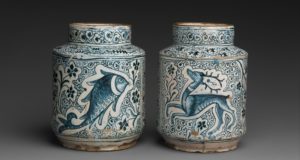
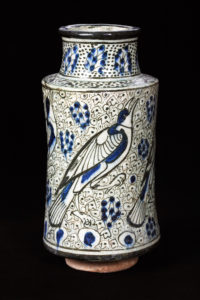
What’s an albarello?
The term albarello is used for a cylindrical jar with a constricted base and a short, wide neck. In the 15th century, Spanish and Italian potters became famous for their tin-glazed products, including the albarello. However, both the glazing technique and the shape of the albarello were imports from the Middle-East.(fig. 1) In this article I’ll tell a bit about the Spanish and Italian albarelli of the late middle ages and the Renaissance.
In the video below you can watch a reconstruction of a 15th century albarello being made. Remember to put your sound on.
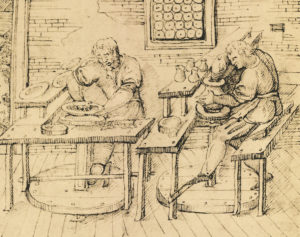
How were albarelli made in the Renaissance?
My reconstruction method differs slightly from the traditional production process of the albarello. We know quite a bit about the manufacture of early Italian maiolica because of Cipriano Piccolpasso (1524 – 21 November 1579). He has been so kind to leave a manual behind called Li tre libri dell’arte del vasajo – The three books of the potter’s art. It gives us the opportunity to compare the potter’s wheel in the video to Piccolpasso’s illustration.(fig. 2) There are three main differences. Firstly, the 16th century wheel was mostly made of wood. Secondly, it had plain bearings instead of ball bearings. The third difference is that, according to Piccolpasso, the wheel head, on which the clay was shaped, used to be especially designed for specific wares. If the potter needed to throw another shape he would switch the wheel head.[1] I don’t know how widely spread this feature was but I’ve never seen it on modern wheels. Regardless of these differences, my wheel probably rotates much like a Renaissance wheel.
The recipe for the white glaze was often based on lead and tin. Lead is a very stable ingredient that provides a low melting point. Sadly, it’s also toxic and harmful to the environment. That’s why I chose to work with a lookalike that does contain tin but no lead.

In the video, I work with a preparatory sketch before picking up the brush. Some albarelli were originally painted without a sketch.[2] The more complicated designs might have been prepared with charcoal. Surprisingly, Piccolpasso doesn’t write a word about it but a number of almost identical tin-glazed products has been preserved, suggesting that the designs were laid out in a different material before they were painted.[3] In a well-known copying technique, the lines of the design are traced on a piece of paper with pinholes. The potter puts the paper over the glazed surface of the pottery and dusts finely ground charcoal over it. The dust travels through the holes and settles on the glaze, leaving a pattern as a guide for the painter.[4]
The color palette in my reconstruction is limited to cobalt blue only. The earliest European tin-glazed earthenware used to be executed in manganese brown, copper green, sometimes yellow and a light blue. The darker cobalt blue was introduced later along with yellow and orange made with antimony and ferric oxide.[5] Especially luxurious were designs executed in lustre glazes. These would result in copper, silver and golden decorations. These lustre glazes contained among other things copper, silver and sometimes mercury. They had to be fired in a reducing atmosphere, requiring a third firing stage on top of the already complicated trajectory.[6] Arabic and Spanish potters developed this technique to an unequalled level.(fig.3)

Early European albarelli were fired in wood kilns. Piccolpasso gives us a wonderful drawing of a maiolica kiln.(fig. 4) He mentions that the kiln should reach the proper temperature after eleven hours of firing. Then the potter needs to check the glow of the fire through various spyholes in the kiln wall to make sure that the heat is equally distributed. If not, he will have to play around with the draft to spread the heat properly throughout the kiln.[7]
It was quite a challenge to protect the pottery from flames and other harmful influences. This is why tin-glazed products were put inside so-called saggars. These earthenware cylindrical containers were filled with one or more glazed products and stacked one on top of the other inside the kiln.
It’s good to remember that potteries had small or large groups of employees, allowing different degrees of specialization.[8] Certain ceramists might have spent most of their careers throwing, some others glazing or painting and yet others firing kilns. The idea that one person alone would carry out the whole production process is out of line with the way things usually worked in these kind of potteries.

What was the albarello used for?
Albarelli are often referred to as apothecary jars but various medieval and Renaissance sources point to a more versatile use.
However, medicine storage must have been a major purpose. In a Bolognese edition of The Canon of Medicine by Avicenna from ca. 1440, we find an illustration of a drug store with shelves lined with albarelli.(fig. 5) Italian hospitals also used tin-glazed storage jars, sometimes great amounts. The Hospital of Santa Maria Nuova in Florence, one of the largest in Europe, ordered 200 small glazed albarelli, two large albarelli and three small white albarelli for their apothecary in 1433 or 1434.[9] Some albarelli were made with the emblem of the commissioning hospital. This one for example bears the crest of the Hospital of Santa Maria della Scala in Siena.(fig. 6)
In medieval iconography, we often find biblical women holding albarelli, for example the Myrrhbearers that came to Jesus’ tomb. The albarelli indicate the myrrh that they brought to anoint Jesus’ body. In this detail of a painting by Van Eyck we can see Mary Salome holding what seems to be an albarello of Syrian make.[10](fig. 7)
Another clear indication that albarelli were used as pharmacy jars can be found in labels. In the 15th century, albarelli were by exception provided with a painted label. However, this practice became quite common in the 16th century. This jar is inscribed Laudano – laudanum is a painkiller containing opium.(fig. 8)
Other labels suggest a different purpose. This one for example reads CISSCA:BE and on the reverse side LAFRAN (= Bella Francesca- beautiful Francesca).(fig. 9) It seems that such amorous messages turned the jars into the perfect love-gift, especially if they were filled with sweetmeats.[11] Other domestic ingredients were also stored in albarelli.
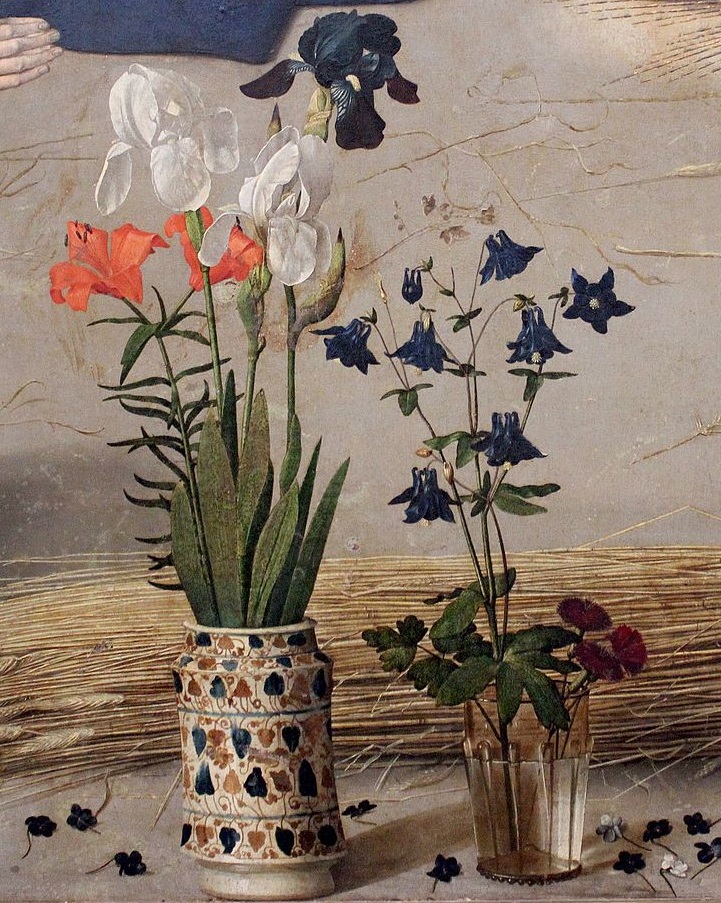
This albarello contained mustard of a fine quality: Mostarda f(ina)(fig. 10) and the jar with the wonderful lady’s portrait must have held a large amount of curcuma (probably turmeric), which was used as a spice, a drug and a yellow dye.[12](fig. 11) This jar could therefore be an example of an albarello used for cosmetics: turmeric was sometimes used by women to dye their hair.[13]
Yet another inscription takes us back to the pharmacy. Pharmacies of the 15th and 16th centuries did not merely provide medicine but other products such as artists’ pigments too. A 16th century albarello mentioned by Henry Wallis is inscribed PILLE DE LAPIS LAZALI, clearly indicating lapis lazuli, the famous blue artists’ pigment.[14]
Another use for the albarello can be observed in many late medieval and Renaissance paintings. One of the most famous examples must be the Portinary Altarpiece painted by Hugo van der Goes in 1475. Right in the foreground of an elaborate scene with the adoration of the shepherds, a still life can be seen with a corn sheaf, flowers, a glass and an iconic example of a Valencian lusterware albarello.(fig. 12) A related but more surprising use for the jar can be found in Carlo Crivelli’s Annunciation with Saint-Emidius from 1486.(fig. 13)
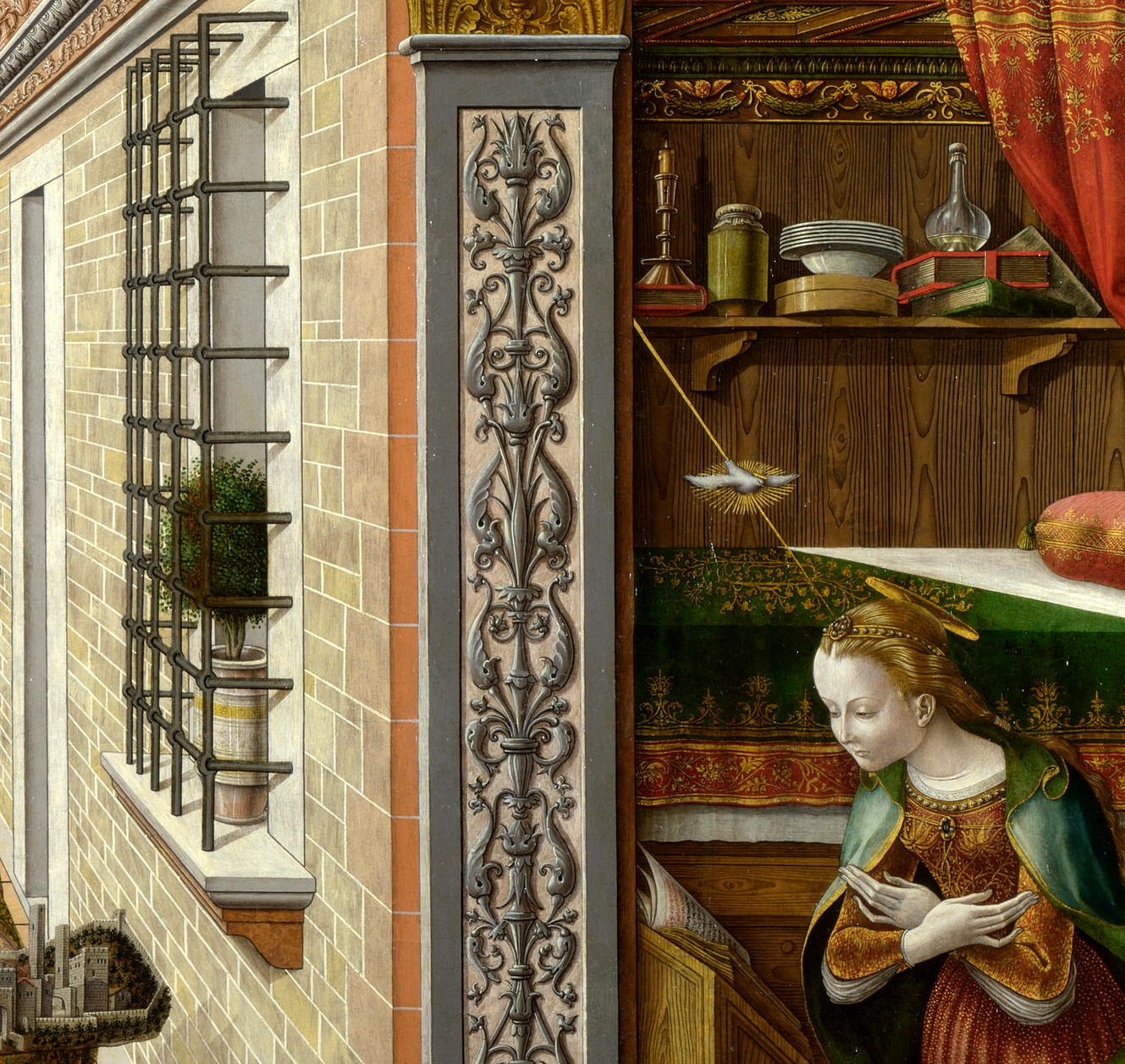
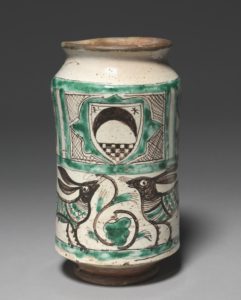
In this painting an exceptionally luxurious planter is depicted – there can be no doubt that it’s in fact an albarello. A second albarello is sitting on a shelf among a carefully arranged mess of domestic items. It’s covered with a piece of cloth or parchment, a common method for which the albarello’s neck lends itself particularly well. This green jar shows that some albarelli were quite unpretentious. Others were made with expensive materials and elaborate decorations. The more luxurious pottery was sometimes part of diplomatic gifts. Lorenzo de Medici, one of the most powerful Florentine statesmen and influential art patrons of the 15th century, received a gift of maiolica vases from the lord of Rimini. He admitted that he valued these ceramics: ‘more than if they were of silver, for their excellence and rarity … and novelty to us here’.[15] The high regard in which precious ceramics stood at the time is emphasized by numerous albarelli with armorials, mottos and even portraits of highborn men and women. This albarello for example bears the arms of the Luna family, lords of Paterna.(fig. 14) Apparently these ceramics strengthened the identity and status of cities, families and individuals. But the heraldic earthenware wasn’t necessarily owned by the ruling families themselves. Others bought them too, showcasing their support.[16]
Last but not least, the status of tin-glazed pottery can be deduced from the confidence of some Renaissance potters. The Masci family of potters wrote in 1498 that their products were: ‘beautiful and unheard of and sold throughout the whole world, and because of this the city of Perugia takes pride and increases its fame and everyone wonders to see these maiolica works.’[17]
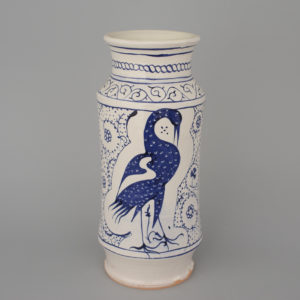
The Masci potters may have been show-offs, but they were also right. In fact, being beautiful may be the one purpose that those old albarelli never lost. Whether the jars are displayed in museums, depicted in books or spread over the internet – there is still a great charm in their shapes, their colors, their pictures and their patterns. The revival of medieval and Renaissance albarelli through reconstructions is witness to their popularity.(fig. 15)
Etymology
The Concise Encyclopedia of Continental Pottery and Porcelain states that the word albarello is of obscure origin[18] and it is true that many hypotheses about the etymology are less than convincing. Is albarello derived from Latin alveolus (a cavity, womb, trough, basin) and ellus (a diminutive)? Or is it related to vulgar Latin albarus, Latin albus (white)? Another creative solution for the riddle is the assumption that Eastern jars were originally made from bamboo sections, supposedly inspiring potters to make similarly shaped jars. According to this hypothesis the Italian term Alberello (young tree) was first applied to the bamboo- and later to the ceramic containers.[19]
A relation with the Arabic Al-barani and al barril [20] seems the most plausible. The term Al-barniyya, plural Al-barani can be attested as early as the 10th century and it has been used for both domestic containers of various shapes and cylindrical vessels with a concave profile intended for the storage of medicine.[21] Ilaria Zamuner points out that the diminutive suffix ello can be found in other Italian words such as the hypernym Vasello or in utello, also derived from Arabic – a terracotta pot for oil storage that could be found in the apothecary as well.[22] This hypothesis coincides perfectly with the origin of the albarello, which lies after all in the Middle East.
Text: Atelier Able
[1] Cipriano Piccolpasso, 2007. Translated by Ronald Lightbown and Alan Caiger-Smith, The three books of the potter’s art. Scolar Press, London. pp. 53-54
[2] Elisa P. Sani, Matthew Reeves and Justin Raccanello, 2017, Majolica before Raphael. Sam Fogg & Paul Holbertson Publishing, London. p. 13
[3] Catherine Hess, 1988 Italian Maiolica, Catalogue of the Collections, The J. Paul Getty Museum, Malibu, California. p. 7
[4] Cipriano Piccolpasso, 2007. p. 30
[5] Catherine Hess, 1988. p. 3
[6] Cipriano Piccolpasso, 2007. p. 31
[7] Cipriano Piccolpasso, 2007. p. 93
[8] Elisa P. Sani e.a. 2017. p. 15
[9] John Henderson, 2006, The Renaissance Hospital – healing the body and healing the soul – Yale University Press – New Haven and London p. 293
[10] Rebekka Theenaart https://www.boijmans.nl/nieuws/uitwisseling-van-culturen-in-museum-boijmans-van-beuningen
[11] Henry Wallis, 1904, London, publisher: Bernard Quaritch, Italian Ceramic Art: The Albarello, A Study in Early Renaissance Maiolica p. 14
[12] Zohar Amar and Efraim Lev, 2017, Arabian drugs in early medieval Mediterranean medicine, Edinburgh University Press
[13] https://www.hermitagemuseum.org/wps/portal/hermitage/digital-collection/10.+porcelain%2c+faience%2c+ceramics/228946
[14] Henry Wallis, 1904, p. 14
[15] Elisa P. Sani e.a., 2017. p. 11
[16] Elisa P. Sani e.a., 2017, p. 20
[17] Elisa P. Sani,e.a., 2017. p. 26
[18] Reginald G. Haggar, 1960. The Concise Encyclopedia of Continental Pottery and Porcelain, André Deutsch,
[19] Catherine Hess 1988 Italian Maiolica, Catalogue of the Collections, The J. Paul Getty Museum, Malibu, California, p. 11
[20] Catherine Hess 1988. p. 8
[21] Ilaria Zamuner, 2018, Ancora sull’ etimologia di Albarello, published in volume 78, issue 1-2 of Cultura Neolatina, Rivista di filologia Romanza fondata da Giulio Bertoni, p. 113
[22] Ilaria Zamuner, 2018. pp. 117, 118, 119
A throwback to the medieval potter’s wheel
The potter’s wheel is already thousands of years old. It’s an amazing invention that allows the potter to work meticulous and fast. Nowadays, many potters are accustomed to the electric wheel to produce their wares but some prefer the old-fashioned human-powered wheels. I’m one of the latter. Since I started making medieval pottery, I have been curious about the development of the medieval kick wheel. How does my modern kick wheel compare to its medieval ancestor? How is a medieval potter’s wheel constructed and how would the construction influence its use?
Apart from these questions, I had the ambition to give throwing demonstrations to show how medieval pottery was made. A reconstruction of a medieval potter’s wheel could possibly answer my questions and provide me with the proper tool for my demonstrations. I decided to dive into experimental archaeology. This is my account of that experiment.
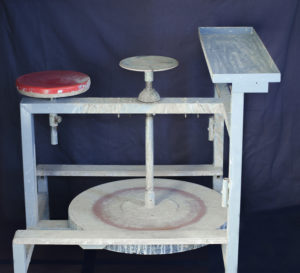
Some foundations and pits of medieval wheels have been excavated. They provide us with information about the size, material and location but no medieval wheels are sufficiently preserved to give a complete image of the shape and construction. However, many images of the time show the medieval potter’s wheel in its full glory.
It seems like there were two main types of wheels in use for pottery in late medieval Europe before 1500. One was a hand-turned wheel that largely resembled a cartwheel with the axle fixed vertically in the floor (images 2 to 11), the other was a kick wheel that looked like a standing spool on a vertical axle (images 12 to 20).
The cartwheel
Some of the cartwheel images show wooden sticks beside the wheel or in the hands of the potter (images 2,3,5,8,9,11). These sticks must have been used to speed up the wheel. Other images suggest that the wheel is accelerated by hand (images 4,6,10). Image 7 doesn’t illustrate either way, here the stick is used by Nigidius to draw lines on the flywheel to prove a point.
The medieval kick wheel
The kick wheel is rotated by pushing the wheel with a kicking motion of the foot, just like my own modern kick wheel. Potters are often depicted with at least one foot close to the flywheel, as if they’re about to give it another swing. They often work with bare feet, maybe to keep their shoes clean and whole but presumably to get a better grip on the flywheel.
The Renaissance kick wheel
A third type of wheel emerges in the course of the 16th century, for as far as I can trace it down. The construction is more or less identical to my own modern kick wheel. The oldest depiction known to me is from De la pirotechnia by Vannaccio Biringucci, published in Venice in 1540. Here, the kick wheel has a construction built around it that provides a place to sit and a shelf to place tools, clay and finished vessels.
These pictures give a wonderful insight into the daily practice of the medieval and post-medieval potter. But they tell us little about the materials, bearings or construction methods that were used for the wheels. In this experiment, I focused on the construction of the medieval kick wheel. The fundamental difference with the Renaissance wheel is the axle. In the case of the medieval kick wheel, the axle is the only static segment. The wheel head, the spokes and the flywheel are all turning around it (image 23). In the Renaissance wheel, the axle is fixed to the flywheel and the wheel head. They all turn simultaneously: the axle functions as a shaft. The construction around it keeps this whole moving unit centered.
I started making sketches with the concept of a static axle in mind. I was curious if it was possible to make the entire wheel of wood. If this would be possible, I argued, it would probably be the cheapest and therefore the preferred design for a medieval potter.
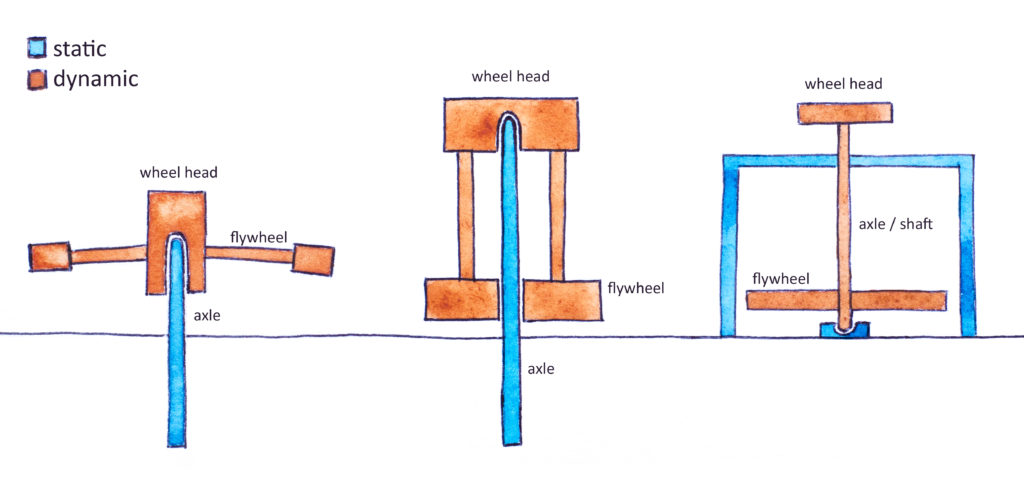
Version 1.0: In 2015, I had the first version of my reconstruction in motion, entirely made of wood. It functioned well enough for throwing small cups and bowls but the wheel wasn’t fast and stable enough to allow a potter to throw large jugs or dishes. It was clear that the wheel needed some improvements. A brief summary of the problems and the solutions can be found in the table below. First of all, the axle was too flexible. The ash that I used turned out to be the wrong type of wood and it was definitely too thin.

Version 1.1: I fixed a thick oak axle (5,5 cm diameter at the base) in a horizontal wooden cross to replace the ash axle. Compared to ash, oak is more rigid. The first metal part that I added was a brass point on top of the axle with a matching brass plate inside the wheel head. This pin was meant to concentrate all friction on top of the axle on a tiny surface to make the wheel run smoother. However, the brass point only worked for as long as it lasted: it wore down quickly. Also, the oak axle wasn’t sturdy enough.
Version 1.2: The hygroscopic properties of the wood made it shrink and expand depending on the humidity. One time with moist weather, I could barely move the wheel because the flywheel was pressing onto the axle, while with dry weather, there was too much space between the axle and the wheel for it to run smoothly. I soaked the turning points in grease to prevent the wood from absorbing moist but this did not solve the problem.
By that time I had paid a visit to the Töpfereimuseum Raeren in Belgium (Pottery Museum Raeren) where I acquired the publication: Raerener Steinzeug – Europaïsches Kulturerbe (Stoneware from Raeren – European heritage) by Ralph Mennicken. In this book, several drawn cross-sections of late medieval and post-medieval potter’s wheels are included. They did not only confirm the principle of a static axle but also gave me more insight into the additional steel parts. These parts would take away my problem of the expanding wood and reduce the friction of the wheel. Said illustrations are cross-sections of the cartwheel-shaped wheel. But since the dynamic principle of these wheels barely differ from the medieval kick wheel, I made all the following changes according to the cross sections in Raerener Steinzeug (1).
A steel pin is pointing down inside the wheel head (image 25). The pin rests in a cavity on top of the axle that can be filled with fat or oil to prevent the steel from wear. The axle is encompassed in two places: at the wheel head and at the flywheel. Here, plain bearings are used: a metal tube around the axle with a corresponding metal tube that is fixed inside the wooden flywheel and wheel head.
I also decided that the construction should be a bit shorter to correspond with the average height-width ratio of kick wheels on medieval and post-medieval images. To make this happen, I shortened the axle and the spokes of the wheel.

A third change was necessary to make the wheel mobile. For a medieval potter, it makes perfect sense to secure the axle in the floor of the workshop. A potter could use rocks, beams and wedges to secure it. Foundations like these have been found in various archaeological sites. But since I started out to make this wheel for demonstrations around the Netherlands and beyond, I’m in need for a moveable wheel.
The image on the playing card from the Hofämterspiel (court employee game) from the Kunsthistorisches Museum Wien in Vienna (image 26) offered a solution. Here the potter’s wheel is fixed in a wooden platform. I had already secured the axle on an oak cross, now I fixed the wooden cross into a platform made of oak. This was a great improvement over the former situation, where I had to fix the axle in the ground by digging holes and hammering wedges on location.
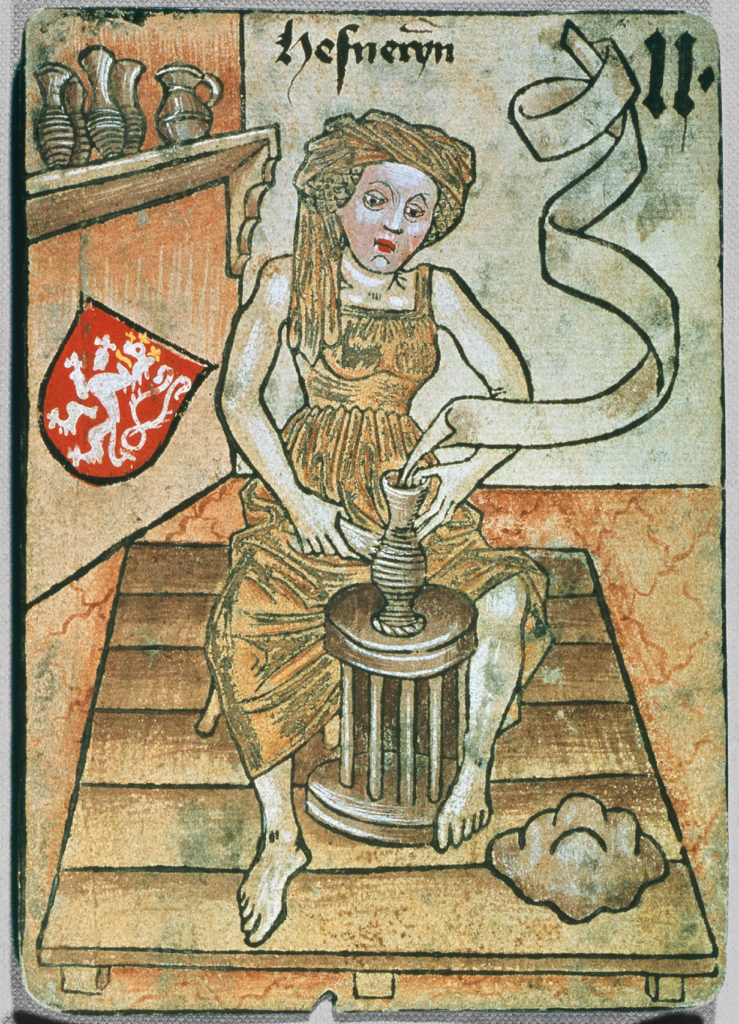
Version 1.3: The last problem was my oak axle. It was too flexible to deal with the forces of a fast turning flywheel. I decided to replace the wooden axle with a steel one. In Raerener Steinzeug – Europaïsches Kulturerbe, Ralph Mennicken describes the results of the excavation of two fundaments of medieval potter’s wheels in Raeren in 2001-2003. The findings date back to the early 16th century at the very latest, but most likely to an earlier time. Ralph Mennicken states: “Legt man die bisherigen technischen Erläuterungen dazu zugrunde, ergibt sich eine vollständige Rekonstruction: In die Pfostenspur eingelassen wird eine mittige Achse in Form eines dicken Stahlstiftes,….” (2)
That is: “The account of all previous technical explanations results into a complete reconstruction: A middle axle shaped like a thick steel pivot is let into the post,….”
This excavation proved that a steel axle was affordable for at least some medieval potter’s workshops and that it seemed rewarding enough for those workshops to make the investment. Armed with this information, I fixed two metal tubes on the new steel axle that corresponded with tubes inside the flywheel and the wheel head. The metal axle (with a diameter of 3 cm) was a lot thinner than the oak one, but it turned out to be stiffer –the vibration was gone (final cross section image 25). In 2018, after these changes, I used the kick wheel during a residency of the Company of Sainte George in the Middelaldercentret in Nykøbing, Falster. There, the wheel worked properly for the first time (image 27).

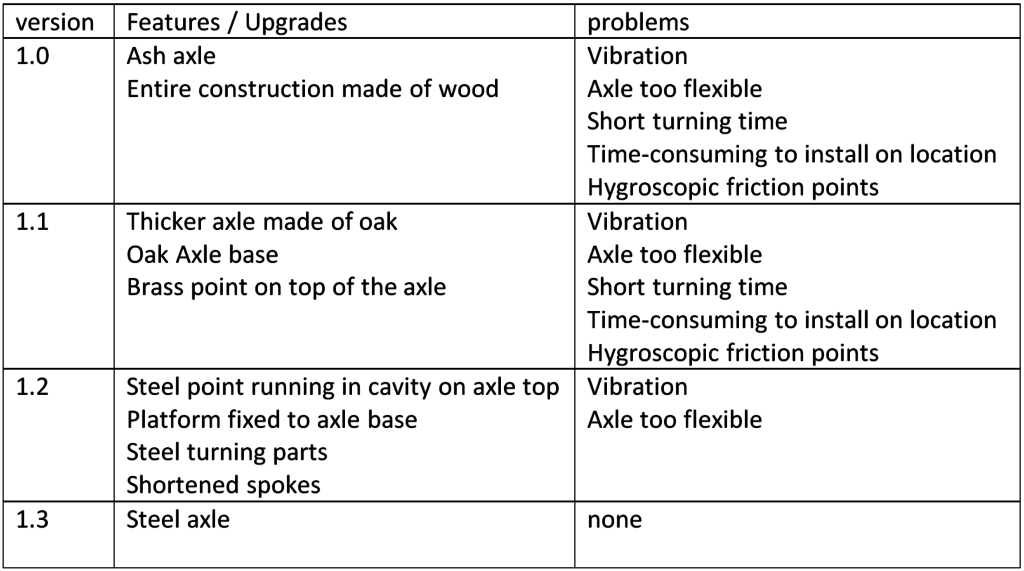
Conclusion
How was the medieval potter’s wheel constructed?
We cannot tell exactly how. Some parts are invisible in the pictures and the additional information from excavations is limited. The shape and material of some pieces has to be guessed. However, kick wheels around medieval Europe might have differed from each other, so there are probably multiple right ways to reconstruct one. Contemporary images confirm a variety of shapes of the same type of wheel.
It seems reasonable that the majority of the construction was made of wood. The medieval wheel had a static axle, in most cases fixed into the workshop floor. Sometimes the axle was installed below floor level, in a round pit. The excavations of potter’s wheels in Raeren point to a steel axle. If steel axles were a standard feature in medieval wheels can be doubted but my experiment does prove that steel parts can enhance the momentum and stability of a wooden wheel. Both the medieval cartwheel and kick wheel were lowered over the top of the static axle. They needed to stay centered and run smoothly at the same time. Grease was used to maintain the contact points.
How would the construction of a medieval potter’s wheel influence its use?
The cartwheel
Some cartwheels were installed below the potter’s seat. They could be made larger and heavier than kick wheels because the potter didn’t have to spread his legs around the wheel to put his feet down. The great weight would make for better flywheels: they could store more rotational energy. Sitting above the pot instead of in front of it had another advantage: the potter could use his or her bodyweight more effectively when forcing the clay into shape. Large amounts of clay that required some strength to center could be worked easier with these wheels. In some images however, the cartwheel is positioned in front of the potter. The previous advantages would not apply for those cartwheels. The downside of all cartwheels is that the potter needs to take his hands from his work to speed it up.
The medieval kick wheel
The major difference with the cartwheel is that it’s moved with the foot instead of the hands. There is no need for the potter to grab a stick to power the wheel and that might speed up the throwing process. Although a potter usually doesn’t shape the vessel while kicking, bringing the wheel to the right speed with the foot might just take as long as moistening both hands for the next pull. Distributing the effort between hands and feet can also contribute to the comfort of the potter.
We may conclude that the different constructions of the two medieval wheels make them more or less useful under different circumstances. Medieval potters might have chosen one type or the other for such reasons.
How does my kick wheel compare to its medieval ancestor?
It turns out, the layout of my modern kick wheel is the same as the renaissance kick wheel and therefore more than 450 years old. Of course, the Renaissance kick wheel didn’t have ball bearings and was largely made of wood. It is likely that steel was only used where necessary.
The layout of the medieval kick wheel is very different because of its static axle. Medieval kick wheels with the axle fixed in the floor couldn’t be moved easily in contrast with my modern kick wheel, which can be picked up and put down much like a piece of furniture. If the potter’s wheel on the playing card from the “Hofämterspiel” in Vienna points to a movable type of medieval kick wheel isn’t certain. The medieval wheel was largely made of wood, where my modern wheel is almost entirely made of steel. Steel was probably used in some critical spots of the medieval construction. However, none of these differences change the throwing process.
The more I improved my reconstruction, the more it worked like my modern kick wheel. With version 1.3, there isn’t much to say about a difference in functionality anymore. Conclusion: my reconstructed medieval kick wheel does not influence the throwing process in any considerable way when compared to my modern kick wheel. This experiment proves that plain bearings, wood and grease can compete with the steel construction and ball bearings of a modern kick wheel.
(1) Ralph Mennicken, Raerener Steinzeug Europaïsches Kulturerbe (Raeren: Grenz-EchoVerlag, 2013), 19.
(2) Ralph Mennicken, Raerener Steinzeug Europaïsches Kulturerbe (Raeren: Grenz-EchoVerlag, 2013), 20.


